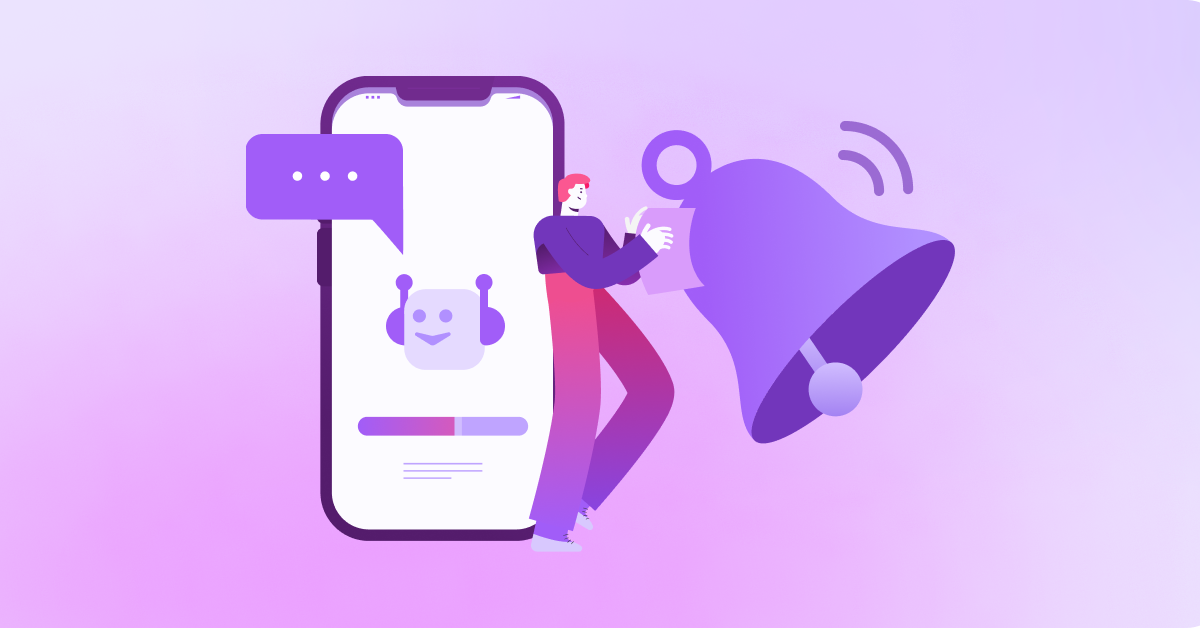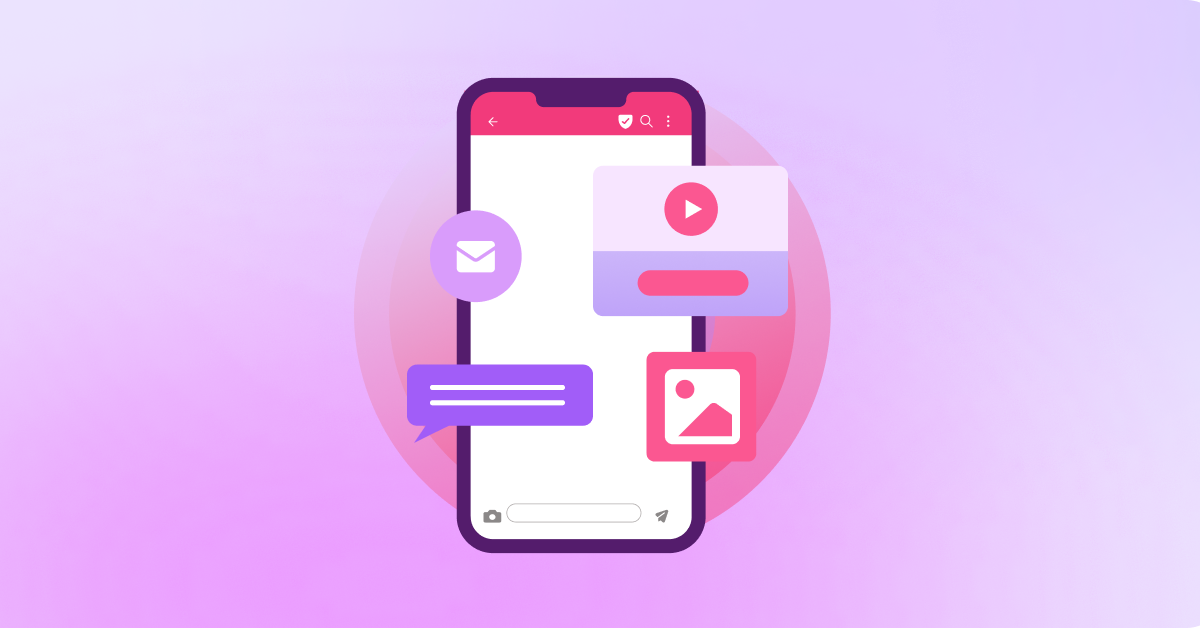
Businesses are messaging customers more than ever, but choosing the right channel can make or break the experience.
SMS offers unmatched reach and reliability, while WhatsApp opens the door to richer, two-way conversations.
Oftentimes, the most effective strategy involves both channels being used in harmony, with SMS acting as a universal fallback.
To help guide you on the best approach for your organisation, this blog post will look at WhatsApp vs SMS, the benefits each brings and some of the common use cases where they provide most value.
WhatsApp vs SMS
Before we dig into the finer details, here’s a quick overview of what sets these two channels apart and why many businesses end up using both.
SMS
SMS (Short Message Service) is the original mobile messaging channel.
It works on every mobile phone by default, requires no internet connection or app installation, and operates over the global mobile network. That means it can reach virtually any user, anywhere in the world, regardless of device type or data access.
Its key strength?
Reach. SMS is unmatched when it comes to delivering short, time-sensitive messages at scale, whether it’s a login code, outage alert or appointment reminder.
WhatsApp Business Messaging
WhatsApp Business Messaging is a separate, application-based messaging service designed for richer interactions.
It requires both the business and the customer to have internet access and the WhatsApp app installed.
WhatsApp supports features like verified business profiles (the green tick), rich media formats (images, videos, PDFs), and interactive message types (quick-reply buttons, lists, carousels) that allow for more engaging, two-way conversations.
It’s often used by businesses for customer support, promotions, or post-sale journeys where a more personalised, visual experience is required.
Security & Privacy
Security and privacy are understandably high on the priority list for enterprise and government organisations when choosing a messaging channel.
Message Privacy
WhatsApp uses end-to-end encryption, which ensures messages can only be read by the sender and recipient. It’s designed to protect private conversations, even across global networks.
SMS, while not encrypted in the same way, continues to play a vital role in trusted business communications, especially for high-volume notifications, alerts and transactional updates.
Its strength lies in its simplicity, reliability and unmatched reach, even without an internet connection.
Rather than comparing encryption alone, the right channel depends on the context.
For regulated industries or highly personal data, WhatsApp may offer added peace of mind. But for urgent, high-availability messaging, SMS remains a secure and proven option, backed by decades of use and global infrastructure.
Identity & Trust
With WhatsApp, businesses benefit from a verified profile and a green checkmark that signals authenticity, helping customers feel confident they’re chatting with a legitimate brand.
SMS uses alphanumeric sender IDs or short codes, which are widely recognised and trusted for notifications. However, in some markets, these can be easier to spoof, so it’s important to work with a secure provider that offers sender protection and traffic monitoring.
In both cases, brand trust comes down to visibility, consistency and working with platforms that prioritise security.
Reach & Availability
A message is only effective if it actually reaches the person it’s meant for.
This section looks at how accessible SMS and WhatsApp are across different audiences and conditions.
Coverage & Accessibility
SMS works on virtually every mobile phone, regardless of the make, model or internet access. As long as there’s a cellular signal, the message will go through. This makes SMS the most universally accessible channel for business messaging.
WhatsApp, on the other hand, depends on users having the app installed and being connected to Wi-Fi or mobile data. While adoption is strong in many countries, usage varies widely across regions and demographics. Some markets rely heavily on WhatsApp for daily communication, while others don’t use it at all.
Understanding your audience is key here. SMS gives you broad, dependable reach, while WhatsApp allows for deeper engagement, if the user base is there.
Message Experience
When it comes to business messaging, how something is said can be just as important as what is said. This section looks at the type and quality of experiences each channel can deliver.
Text vs Rich Media
SMS is built for brevity. It supports single messages up to 160 characters and is perfect for sending short, sharp updates, think one-time passwords, reminders or outage alerts. You can include links, but the message format is plain text only.
WhatsApp, on the other hand, gives you far more room to be creative and interactive.
You can send:
- Images and videos
- PDFs and other documents
- Location pins
- GIFs and emojis
- Interactive elements like quick-reply buttons and carousels
For businesses that want to personalise engagement or offer self-serve experiences, this added richness can be a major advantage.
Conversation Flow
Each platform has its own rules around how conversations start and continue.
With WhatsApp Business Messaging, you need to use pre-approved templates to initiate a conversation. Once a user replies, it opens a 24-hour “customer care window” where you can send free-form messages.
SMS offers more flexibility. There are no approval steps to begin a conversation (provided consent is in place), and the interaction can continue as long as needed, making it well suited for fast, back-and-forth exchanges without restriction.
This flexibility makes SMS ideal for time-sensitive or reactive communications, while WhatsApp lends itself to guided, branded customer experiences where a richer interface can reduce friction.
Delivery & Reliability
A message is only valuable if it reaches its destination and does so in time.
This section looks at how SMS and WhatsApp stack up in terms of speed, network resilience, and visibility into delivery.
Speed & Resilience
SMS is fast. It travels over mobile networks and can often cut through even when internet coverage is patchy. This makes it ideal for time-sensitive messages, especially in areas where mobile data may be unreliable.
WhatsApp is also quick, but it depends on the user being online and connected to the internet. If the person is offline or has poor Wi-Fi, delivery can be delayed.
Delivery & Read Receipts
WhatsApp gives you clear feedback on every message. One grey tick means sent, two grey ticks mean delivered, and two blue ticks confirm it’s been read.
SMS also offers delivery receipts, though this depends on the carrier and device. Read receipts, on the other hand, aren’t a native part of SMS, so visibility into engagement is more limited.
Common Use Cases
Now that we’ve compared the core features of SMS and WhatsApp, let’s look at how businesses are using each channel in the real world and where each one works best.
Urgent Alerts & One-Time Codes
SMS is often the go-to channel for time-sensitive messages like system outages, delivery delays, or login verification codes. Because it doesn’t require an app or internet connection, you can count on it to reach nearly anyone, instantly.
That said, in regions where WhatsApp adoption is extremely high, some businesses are using it for multi-factor authentication (MFA) methods as a more cost-effective alternative. But only when they know their audience will be online and ready to engage.
Customer Care & Support
For two-way conversations, WhatsApp typically shines. Customers can reply with context, send photos, receive documents or interact with buttons to get faster resolutions.
Need to send a warranty PDF? Guide someone through troubleshooting? Let them choose a service window from a list? WhatsApp enables all of that, making support more conversational and less transactional.
Marketing & Reminders
Here, a blended approach often works best. Use SMS to deliver time-critical updates like appointment confirmations or delivery windows, where you need fast, universal reach.
But when running a promotional campaign, especially to opted-in customers, WhatsApp offers a richer experience. Think: a limited-time offer with a product image, or a message series with carousel-style content and clear CTAs.
Choosing The Right Mix
There’s no one-size-fits-all approach when it comes to business messaging. The best strategy depends on your audience, the message type, and what you’re trying to achieve.
Key Decision Factors
To help decide which channel (or combination of channels) is right for your organisation, ask:
- Is this message time-sensitive or mission-critical?
- Does my audience have strong WhatsApp adoption in their region?
- Do I need to include media, documents or interactive buttons?
- Is this a one-way alert, or do I want to start a conversation?
- Do I have the right consent and opt-ins in place?
Thinking through these questions can help clarify which channel will deliver the best experience, both for your business and your customers.
The Blended Strategy & SMS Fallback
In most cases, the smartest approach isn’t choosing one or the other, but combining both. WhatsApp gives you the tools to create rich, interactive conversations. But SMS remains essential for reach, especially when your customer doesn’t have WhatsApp or isn’t connected to the internet.
That’s why many enterprises use SMS as a fallback, first attempting delivery on WhatsApp for an enhanced experience, and automatically switching to SMS if the message isn’t received.
This hybrid approach offers flexibility, reliability and a better overall customer experience. And with the right platform behind you, it can all happen seamlessly.
Frequently Asked Questions
Is WhatsApp SMS?
No. SMS uses the mobile network; WhatsApp runs on the internet. They’re different technologies with different strengths.
Which is better for business messaging: WhatsApp or SMS?
Neither is better across the board. Use SMS for urgent, time-critical messages. Use WhatsApp for richer conversations with media and buttons.
Is WhatsApp more secure than texting?
For message privacy, yes. WhatsApp offers end-to-end encryption. SMS isn’t encrypted the same way but is still widely trusted when paired with a secure platform.
Can I use both channels in the same workflow?
Yes. Many businesses do. With a platform like Soprano, you can deliver via WhatsApp first and fall back to SMS if it’s not delivered.
Message Customers via SMS and WhatsApp with Soprano
Choosing the right messaging channel isn’t always black and white, but with Soprano, you don’t have to pick just one.
With built-in enterprise-grade security and more than 30 years of messaging expertise, our omnichannel communication platform gives you the flexibility to reach customers on both SMS and WhatsApp, all from one place.
Explore Soprano’s enterprise-grade solutions for SMS and WhatsApp today.
Speak With An Expert
Need help deciding what mix is right for you?
Whether you’re looking to scale your messaging strategy or boost engagement across key touchpoints, our team can help you make it happen.



